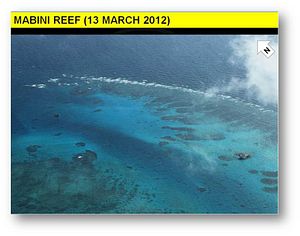On Thursday the Philippines released photos to validate its claim that China is building structures and a possible airstrip on the disputed Johnson Reef.
As Shannon reported yesterday, on Wednesday the Philippines accused China of building structures on the disputed Johnson Reef in the South China Sea, which Manila said was in violation of the non-binding 2002 Declaration on the Conduct of Parties in the South China Sea agreement signed between China and the 10 member states of the Association of Southeast Asian Nations (ASEAN).
On Thursday the Philippines Department of Foreign Affairs (DFA) released four overhead shots of the Reef that date from between March 2012 and March of this year. The photos appear to show in stages China’s reclamation of the Johnson Reef, which the Philippines refers to as Mabini Reef. A DFA spokesperson said that the photos had been obtained by Philippine intelligence sources.
“These actions are considered destabilizing and in violation of the Declaration on the Conduct of Parties in the South China Sea (DOC) and international law,” the DFA said in a statement, the local news outlet GMA Online reported.
The Philippines has speculated that China is preparing to build an airstrip on the disputed reef in order to enhance its power projection capabilities in the South China Sea. Building structures on the reef could also bolster China’s claims of sovereignty over surrounding waters and isles.
The Philippines considers the Johnson Reef to be part of the Kalayaan Island Group (KIG), which it controls. Along with the Philippines and China, Vietnam and Taiwan also claim the Johnson Reef.
DFA spokesperson Charles Jose also expressed concerns on Thursday that China’s moves on the Johnson Reef are designed to undermine the Philippines ongoing international arbitration efforts. The Philippines has appealed to an international tribunal to determine the outstanding sovereignty issues it has with China in South China Sea. Beijing has refused to participate in the proceedings, which it characterizes as illegitimate.
According to Jose, China is trying to re-define the Johnson Reef as an island in order to bolster its claims of sovereignty over surrounding waters. Under the terms of the UN Convention of the Law of the Seas (UNCLOS), a feature that is defined as an island contains a 200 nautical mile exclusive economic zone (EEZ). Thus, a state possessing sovereignty over an island can claims the EEZ it generates. By contrast, smaller features like reefs or rocks do not have EEZs, according to UNCLOS.
“In our protest to China, we said this reclamation could undermine the arbitral tribunal’s review of our case because of the reclamation,” Jose said at a press briefing on Thursday, GMA Online reported. He added: “The nature of (Mabini Reef’s) land feature is being altered so the status quo is being changed.”




































